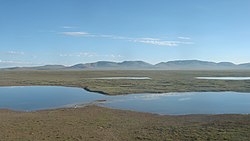Nagqu 那曲市 ནག་ཆུ་གྲོང་ཁྱེར། Nagchu | |
|---|---|
 Rural Nagqu | |
 Location of Nagchu Prefecture within China | |
| Coordinates(Nagqu municipal government): 31°28′34″N92°03′04″E / 31.476°N 92.051°E | |
| Country | China |
| Autonomous region | Tibet |
| County-level divisions | a district and 10 counties |
| City seat | Seni District |
| Area | |
• Total | 450,537 km2 (173,953 sq mi) |
| Population (2010) [1] | |
• Total | 462,381 |
| • Density | 1.0/km2 (2.7/sq mi) |
| GDP | |
| • Total | CN¥ 9.5 billion US$ 1.5 billion |
| • Per capita | CN¥ 19,508 US$ 3,132 |
| Time zone | UTC+8 (China Standard) |
| ISO 3166 code | CN-XZ-06 |
| Website | www |
- 1 2 3 4 5 那曲地区历史沿革 [History of Nagqu Prefecture] (in Chinese). XZQH.org. Retrieved February 24, 2016.
- ↑ "那曲地区撤地设市--时政--人民网". politics.people.com.cn. Retrieved December 11, 2023.
- ↑ Wang, Vivian (June 8, 2023). "Behind a Rare Clash, a Fight Over Faith in China". The New York Times. ISSN 0362-4331 . Retrieved June 10, 2023.
- ↑ 国务院关于同意西藏自治区撤销那曲地区设立地级那曲市的批复 (in Chinese). Sohu. October 2, 2017. Retrieved August 17, 2019.
- ↑ 撤地设市 那曲成为西藏第六个地级市 (in Chinese). zwww.com. May 18, 2018. Retrieved August 17, 2019.
- 1 2 3 Google Maps, Google, accessed 17 August 2019.
- ↑ "Arctic, Antarctic, and Alpine Research, Volume 39". Institute of Arctic and Alpine Research, University of Colorado at Boulder. 2007. p. 694.
- 1 2 3 4 那曲地区概况 (in Chinese). xzqh.org. Retrieved August 17, 2019.
- 1 2 "Impacts of climate change on Tibetan lakes: patterns and processes" (PDF). University of Reading. 2018. Retrieved August 17, 2019.
- ↑ "Glacier study reveals chilling prediction". China Daily. 2004. Retrieved August 17, 2019.
- ↑ "Weather anomalies in Tibet pose challenge to agriculture: experts". Xinhua. July 11, 2019. Archived from the original on August 17, 2019. Retrieved August 17, 2019.
- ↑ 1991-2020 normals "Climate averages from 1991 to 2020". China Meteorological Administration . Archived from the original on April 17, 2023.
- ↑ 1981-2010 extremes 中国气象数据网 – WeatherBk Data [China Meteorological Data Network - WeatherBk Data] (in Simplified Chinese). China Meteorological Administration . Retrieved April 14, 2023.
- ↑ 1971-2000 Extremes 那曲城市介绍 (in Simplified Chinese). Weather China. Archived from the original on April 20, 2023. Retrieved May 27, 2011.
- ↑ Zhijie Liao (2017). Thermal Springs and Geothermal Energy in the Qinghai-Tibetan Plateau. Springer. p. 285. ISBN 978-981-10-3485-5.
- ↑ Guangyan Zhou (1988). Zhongguo xi bu di qu kai fa zhi nan. p. 395. ISBN 978-7-5046-0022-6.
- ↑ United States. Foreign Broadcast Information Service (1994). Daily report: People's Republic of China. Distributed by National Technical Information Service. p. 51.
- ↑ "Qinghai-Tibet Railway Enhances the Development of Tibet". Tibet Magazine. Retrieved August 17, 2019.
- ↑ "Hydropower station put into use in Tibet's no-electricity area". Xinhua. June 3, 2019. Archived from the original on June 7, 2019. Retrieved August 17, 2019.
- ↑ "Chinafrica". 1990. p. 24.
- ↑ 西藏那曲撤地设市,成为中国平均海拔最高、最年轻城市 (in Chinese). The Paper. April 25, 2018. Retrieved August 17, 2019.
- ↑ "Tsanden Monastery in Sog County, Nagqu". Mysterioustibet.com. Retrieved August 17, 2019.
- ↑ "Sog County overview". Mysterioustibet.com. Retrieved August 17, 2019.
- ↑ "Zhajun Monastery in Baingoin County, Nagqu". Mysterioustibet.com. Retrieved August 17, 2019.
- ↑ Xiaoming Zhang (2004). China's Tibet. p. 33. ISBN 978-7-5085-0608-1.
- ↑ "Kyagqen Horse Racing Festival in Qangtang". China Tour Package. Retrieved August 17, 2019.
- ↑ "People Wearing Hats During Horse Racing Festival in China's Tibet". Women of China via Xinhua. August 13, 2019. Retrieved August 17, 2019.
- ↑ "Baingoin County Attractions". Mysterioustibet.com. Retrieved August 17, 2019.
- ↑ Zheng, Du; Zhang, Qingsong; Wu, Shaohong (2000). Mountain geoecology and sustainable development of the Tibetan Plateau. Springer. p. 238. ISBN 978-0-7923-6688-1 . Retrieved August 17, 2019.
- ↑ 安才旦 (January 1, 2003). Tibet China: Travel Guide. China Intercontinental Press. p. 44. ISBN 978-7-5085-0374-5.
- ↑ "Restaurant Review: Tiny Cordyceps Fungus Packs A Nourishing Punch At Ganglamedo". Weekender.com. August 10, 2018. Retrieved August 17, 2019.
- ↑ Branigan, Tania (January 12, 2010). "Tibet to be location of highest airport in the world". The Guardian . Retrieved August 17, 2019.
- ↑ "Young Living Buddha walks path of enlightenment". The Telegraph. September 29, 2015. Retrieved August 17, 2019.
Further reading
External links
Wikimedia Commons has media related to Nagqu .
| Nagqu | |||||||
|---|---|---|---|---|---|---|---|
| Chinese name | |||||||
| Chinese | 那曲 | ||||||
| Hanyu Pinyin | Nàqū | ||||||
| |||||||
| |||||||
Lhasa (capital) | |
| Prefecture-level cities | |
| Prefecture | |
** Southern portions of these counties are claimed by the People's Republic of China as part of the South Tibet area, but are administered by India. | |
